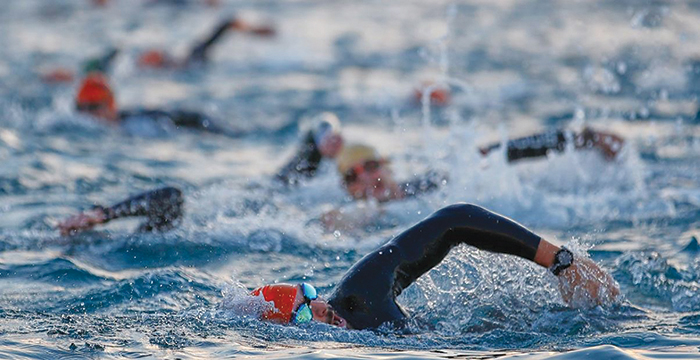Come Saturday, 3,800 athletes from around the world will descend on Jones Beach State Park for Ironman 70.3 New York. Along with grit and determination, they will pump $13 million into Long Island’s economy, organizers say.
This year marks Long Island’s first Ironman triathlon, which is sponsored by Northwell Health. At this event, Jones Beach will take center stage as a destination. The iconic state park, with its famed white-sand beach, was selected for its “beauty and its infrastructure,” Dave Christen, senior regional director for The Ironman Group told LIBN.
“We know the athletes will have a great experience,” Christen added, citing proximity to the airports, hotels and restaurants.
Ironman 70.3 is a half triathlon, but from an economic and planning standpoint, there’s a lot more to this swim-bike-run event.
bring in a new audience who never
considered coming to Long Island before.’ Photo by Judy Walker
The event “attracts a very affluent audience,” said Kristen Reynolds, the president and CEO of Discover Long Island, which was brought in for promotion. An Ironman is a “very expensive sport,” in which athletes invest “thousands of dollars on bicycles” as a starting point, she said.
Like other visitors to Long Island, they will spend their dollars on food, beverage, lodging, retail and services, contributing to the tourist economy. In 2022, visitor spending and tourism-related employment grew to $6.6 billion and 72,606 jobs, respectively. That’s according to New York State, which last week released a series of regional reports by Tourism Economics. Suffolk County represents 56% of the region’s visitor spending, and Nassau 44%.
Working to promote the region as a destination, Discover Long Island has a contract with Suffolk County, and up until Dec. 31, 2022, had a contract with Nassau County. The agency has since responded to a request for proposals from Nassau County.
“We’re still waiting” to hear back, Reynolds said about the proposal submitted to Nassau. As of now, she said, the two organizations are “not official partners.”
Meanwhile, over at Jones Beach, crews are ready.

Island’s first Ironman. Courtesy of Destination Long Island
“We’ve hosted triathlons before, but never an Ironman,” George Gorman Jr., the regional director of New York State Office of Parks, Recreation and Historic Preservation, told LIBN.
Still, Gorman said, “hundreds of thousands of people” visit Jones Beach for events such as the Bethpage Air Show and the July 4th fireworks presentation. So officials were confident about accommodating the Ironman event.
Talks about bringing Ironman to Jones Beach began back in 2019, but stopped amid COVID-19. When discussions resumed earlier this year, “we made some changes back and forth, came up with a good plan and came to agreement,” Gorman said.

triathlons before, but never an Ironman.’ Photo by Judy Walker
Many local governments and agencies coordinated in this effort, including Nassau County, the Towns of Oyster Bay and Babylon, and state agencies that include police, the Department of Transportation and more. Lifeguards were retained to oversee the swim portion of the competition in Zach’s Bay.
Reynolds pointed to additional “internationally acclaimed athletic events” ahead, including Belmont Stakes (which may move temporarily to Saratoga while Belmont Park undergoes a $455 million renovation), and the 2025 Ryder Cup at the Bethpage Black.
These events “open doors to other opportunities that can bring in real economic impact,” Reynolds said. “Events like these bring in a new audience who never considered coming to Long Island before. They have no idea that Long Island is so beautiful and lush, with the Gold Coast mansions, the Hamptons and the vineyards.”
Ironman-style happenings are “very high-profile events” with a “very strong following,” Reynolds said. Gearing up for the event, Discover Long Island worked with local agencies as well as hotel partners to alert them to what the athletes might need, including bike storage, early breakfasts and late checkouts. The athletes, Reynolds said, “are willing to pay extra” for these services.
Discover Long Island, Reynolds said, is providing local guides to the athletes, spotlighting downtowns and restaurants, with an eye towards prompting “future leisure trips.”
Ironman events tend to flow in dollars before and after each triathlon, Christen said.
“Athletes pre-visit” as they conduct “reconnaissance – they want to see the course,” Christen said. And after, they often return to “celebrate their milestone, without the pressure of the race.”
Organizers say they took painstaking measures in mapping the event so as not to detract from the traditional beach season, and with an eye towards minimizing any impact on the surrounding communities.
For example, Wantagh State Parkway, serving as the bike course, will be inaccessible, though the nearby Meadowbrook Parkway and Robert Moses Causeway will remain open. And Fields 4, 6 and West End 2 will also be open for beachgoers.
Ironman events typically bring 1,000 volunteers, many from nonprofits who sign up to distribute information, beverages, nutrition and more. These volunteers can apply for Ironman’s grant program. One group, Christen said, funded its volleyball equipment through grant funding.
“We want to be a part of the fabric on Long Island,” Christen said.
Already, plans are in the works for organizers to debrief post-event and then discuss 2024.
As long as everyone’s on board, “we’re looking forward to many years on Long Island,” Christen said.
Image and article originally from libn.com. Read the original article here.

